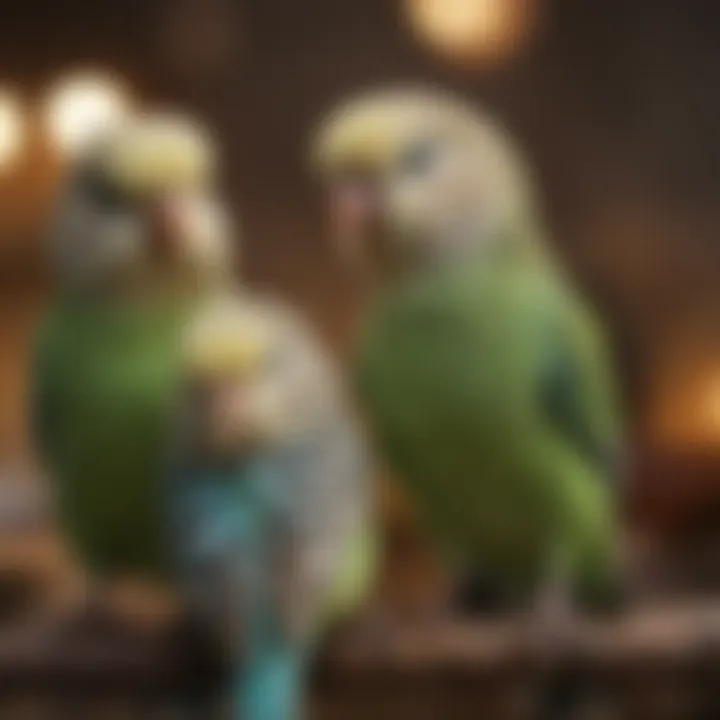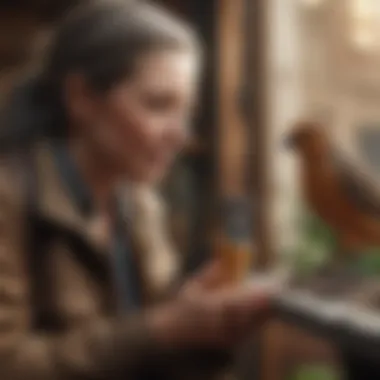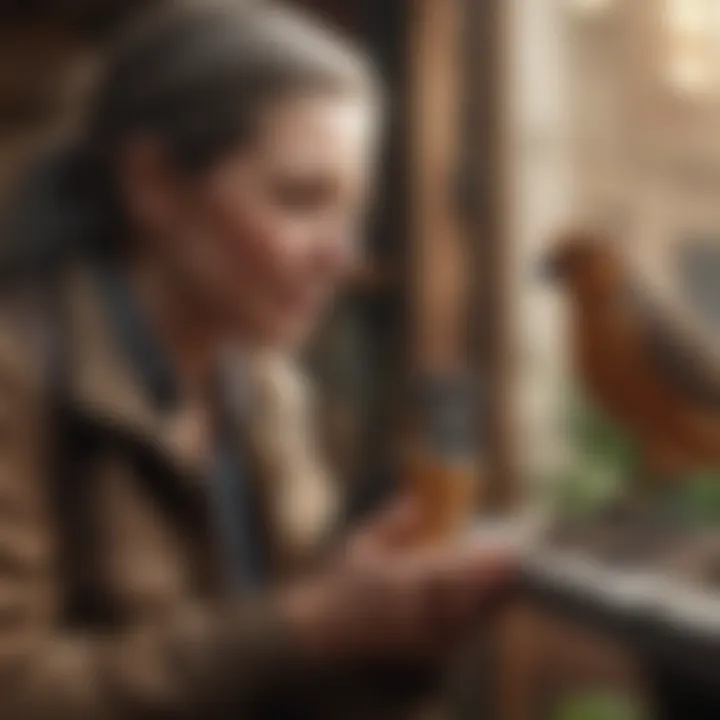Caring for Gentle Non-Biting Pet Birds


Intro
Pet birds can bring delightful charm and vibrancy to any home. While many bird species may show a tendency to nip, some breeds are known for their more gentle ways. Understanding these lovable creatures, and how to provide the right environment and care for them, is key for nurturing a fulfilling relationship. This piece not only highlights the wonderful world of non-biting birds but also digs deep into their needs, behaviors, and the best practices for keeping them happy.
Care Tips
Daily Care Routines
A daily routine can help create a harmonious environment for you and your pet bird. Start by ensuring fresh water is always available. Changing the water every morning is a simple yet effective way to keep your feathered friend healthy. Besides, spend a bit of time each day interacting with your bird by talking or simply being nearby. Birds are social creatures; they thrive on attention and companionship.
Cage Setup and Maintenance
The cage is your bird's home, and setting it up thoughtfully goes a long way. It should be roomy enough for the bird to move around freely. Equipment like swings, ladders, and perches can create an inviting space. Ensure the cage is positioned in a safe location—not too close to windows where sudden sounds might startle them. Regular cage cleaning helps maintain hygiene, so set a schedule to deep clean at least once a week.
Hygiene and Cleaning Practices
Daily spot-checks for droppings and leftover food can help keep the cage clean. Use a soft cloth with warm soapy water for cleaning. Avoid strong chemicals; they can be harmful to birds. For deeper cleaning, use safe bird-friendly products to wash toys and accessories periodically. Keeping everything fresh and tidy helps in preventing illness.
Seasonal Care Adjustments
Birds can be affected by changes in weather, so adjusting care according to the seasons is necessary. In colder months, making sure their cage is adequately insulated and warmth is provided can help prevent health issues. Conversely, during the hotter days, ensure they have access to shade and perhaps a cool bath now and then to keep them comfortable.
Behavioral Insights
Understanding Bird Body Language
Birds communicate a lot through body language. Understanding these signals can change the game in acknowledging their comfort levels. A bird that fluffs up its feathers might be feeling cold or threatened; conversely, a relaxed bird will stand tall or preen its feathers.
Common Behavioral Issues and Solutions
Sometimes, even the sweetest birds can show unusual behaviors. For instance, if a bird begins to pluck its feathers, it could indicate stress or boredom. Solutions can range from increasing playtime to ensuring a well-structured routine. Intervening early can prevent issues from escalating.
Positive Reinforcement Techniques
Using positive reinforcement helps in shaping good behavior. Whenever your bird shows desired traits, reward them with treats or praise. This approach strengthens bonds and encourages trust. It's like a gentle nudge in the right direction, making it easier for them to learn.
Social Interaction Needs
Fulfilling the need for social interaction is crucial. Engage with your bird as much as possible, but allow them space when they need it too. Having another bird of similar temperament can also create opportunities for natural interaction.
Nutrition Guides
Essential Diet Components
A well-rounded diet for your non-biting pet bird should include seeds, pellets, fresh vegetables, and a small portion of fruits. Be mindful of the specific needs of the breed you own. For example, parakeets thrive on varied diets, while budgies also enjoy leafy greens.
Safe and Toxic Foods
Some foods are detrimental to birds. It's essential to be aware of potential dangers. Avoid giving them chocolate, avocado, or caffeine. On the brighter side, foods like carrots, apples, and peas are safe and can be delightful treats.
Supplements and Treats
Incorporating supplements can enhance your bird's diet. Offer occasional treats like millet sprays or Omega-3 rich foods to support their health. Treats should complement their main diet, not replace it.
Feeding Strategies for Different Species
Tailor your feeding habits to your bird's species. Smaller birds, like canaries, may prefer finely ground pellets, while larger birds might enjoy mix seeds. Observing how your bird interacts with different food types helps in curating their meal plan.
Wellness and Health
Routine Health Checkups
Regular vet visits ensure any potential health issues are caught early. A check-up at least once a year is wise. During these visits, you can learn about specific health considerations for your bird's breed.
Identifying Symptoms of Illness
Monitoring your bird’s behavior is vital in identifying sickness. Symptoms such as changes in eating habits, lethargy, or unusual vocalizations may indicate health issues. Early detection is key to successful treatment.
Preventative Care and Vaccinations
Preventative care cannot be overlooked. Discuss with an avian vet about vaccinations that might be necessary for your pet. They can provide crucial advice regarding health maintenance.
Mental and Emotional Well-being
Like humans, birds have emotional needs. Providing a stimulating environment is essential for their mental health. Rotate toys regularly and engage with them during playtime to keep their lively spirits up.
Enriching Activities
Toys and Playtime Ideas
Investing in various toys helps maintain their physical and mental health. Toys that challenge their intellect, like puzzles, encourage problem-solving and keep them entertained. Remember, birds love to chew, so offering safe materials can satisfy that natural instinct.


Training and Tricks
Training lasts a lifetime and positively impacts the bond you share. Incorporating simple tricks, like step-up commands, can be fun for both you and your bird. Consistency is crucial, so practice regularly.
Outdoor Activities and Interaction
Outdoor time can be refreshing. A secure aviary can allow birds to enjoy the fresh air and natural sunlight. Supervised outings with a harness can also provide new experiences while keeping them safe.
DIY Projects for Mental Stimulation
Creating homemade toys using household items can engage your bird's creative instincts. For instance, crafting toy swings from popsicle sticks or introducing cardboard boxes can offer hours of fun. Enriching their playtime with DIY projects reflects your love and attentiveness to their happiness.
Preface to Non-Biting Pet Birds
When considering pet birds, the notion of a non-biting companion can be both comforting and appealing. This article dives into understanding the diverse types of birds that tend to exhibit gentle behavior and how to foster such traits in their environments.
Understanding non-biting behavior is crucial for pet bird owners, aspiring bird parents, and breeders alike. It highlights the significance of nurturing relationships that prioritize emotional well-being, thus reducing aggressive tendencies. Those looking to expand their flock or introduce a feathered friend to their home can greatly benefit from knowledge of avian behavior and temperament. This exploration not only makes for a harmonious living arrangement but also enriches the lives of all involved.
Definition of Non-Biting Behaviors
Non-biting behaviors in birds encompass a spectrum of calm, friendly actions that signify comfort and trust in their owners. Common signs include softly chirping, playful interactions, and engaging with toys instead of resorting to biting. Often, these behaviors signal that a bird feels secure in its surroundings.
Understanding what constitutes non-biting behavior can help owners recognize their pet’s moods and emotional states. For instance, a bird that fluffs its feathers and leans into human touch is usually showing affection, whereas a bird that hisses or flies away may be showing discomfort. When pet owners can interpret these subtle cues, they foster a trusting bond.
Importance of Understanding Avian Behavior
Understanding avian behavior is fundamental to nurturing a positive relationship between birds and their caregivers. Birds are complex creatures with unique social needs and preferences. Grasping their behavior helps in creating an environment conducive to their well-being.
This understanding translates to practical benefits:
- Reduced Stress: Knowing when a bird is stressed allows owners to address concerns promptly.
- Improved Bonding: Awareness of their behavior lets caregivers interact in ways that foster trust.
- Prevention of Aggression: Understanding triggers for aggression can help in minimizing biting incidents.
In essence, a well-informed bird owner can create an environment where their pets feel safe to express themselves without resorting to biting. This knowledge serves as the foundation for positive interactions, ultimately leading to a more fulfilling companionship.
Breeds Known for Gentle Temperament
When considering non-biting pet birds, the breeds with gentle temperaments stand out as ideal companions. They not only provide the joy of avian friendship but also reduce the likelihood of aggressive behavior, which is a common concern for first-time owners. Understanding these breeds helps bird enthusiasts select the right feathered friend who can integrate smoothly into their lives. Additionally, learning about the temperament of various species can guide expectations and training approaches, ultimately fostering a loving environment.
Budgerigars: The Affectionate Parakeet
Socialization and Playfulness
Budgerigars, or budgies as they are affectionately called, are a cornerstone in the world of pet birds. Their social nature is a core aspect of their character. This species thrives on interaction, making them playful companions for individuals and families alike. The more socialized a budgie is from a young age, the less likely it is to develop biting tendencies due to feeling secure and confident in its environment.
One of the key characteristics of budgies is their innate ability to form bonds with their owners. A budgie that receives regular attention will learn to associate humans with positive experiences. This not only enhances their personality but significantly diminishes the chances of aggressive behavior. Their playful antics and mimicry of sounds, including human speech or simple tunes, only serve to strengthen the bond between bird and owner.
However, it’s important to note that while these birds are generally friendly, neglecting their social needs can lead to anxiety, resulting in defensive behavior. Hence, regular socialization is necessary to maintain their cheerful disposition and reduce the likelihood of biting.
Common Care Practices
Caring for budgerigars goes beyond just feeding them a balanced diet; it requires a thoughtful approach. Proper care practices include maintaining their living environment, offering fresh fruits and vegetables, and ensuring they have an adequate supply of clean water.
The key characteristic here is their need for mental stimulation. Budgies are intelligent and curious birds. Providing them with a variety of toys will keep them occupied and happy, which in turn fosters playful behaviors. Ensuring that their cage is spacious enough also plays a role in their well-being; the more room they have to move around, the happier they tend to be.
A unique feature of budgie care is routine interaction. Regular handling and speaking to your budgie enhances your relationship and encourages them to view humans as companions rather than threats. If a budgie feels safe and engaged, they are much less likely to exhibit biting behavior when confronted. However, requiring consistent attention can be challenging for owners who are frequently busy, which might inadvertently influence the bird's behavior if not managed properly.
Cockatiels: Companions with Sweet Natures
Vocalizations and Bonding
Cockatiels are often known for their gentle and affectionate nature. One of the key aspects contributing to their popularity among bird lovers is their vocalizations. These birds are much more than just beautiful creatures to look at; they are natural communicators. Their ability to whistle tunes or mimic sounds creates a unique avenue for bonding with their human companions.
This vocalization serves as a bonding mechanism. When a cockatiel whistles back at you, it’s not just an amusing interchange; it demonstrates their willingness to connect. Engaging with them through sound often encourages positive emotional exchanges, promoting a sense of safety and comfort. Well-socialized cockatiels are less likely to bite, as they feel secure and loved in their environment.
However, some owners may find the sound levels to be a challenge. Cockatiels can be quite loud if they’re bored or if their needs aren’t being met. Understanding their need for interaction and mental stimulation is vital to maintaining a harmonious living environment.
Care and Enrichment Needs
Caring for cockatiels requires understanding their specific enrichment needs, which are crucial for their happiness. This includes not only a varied diet, consisting of high-quality pellets, seeds, and fresh fruits or veggies, but also activities that keep their agile minds engaged.
Cockatiels thrive in an environment rich with opportunities for exploration—such as toys, perches, and climbing structures. The key characteristic of cockatiel care centers around keeping them engaged; boredom can lead to destructive behaviors, including biting. Regular interaction such as playtime outside the cage and stepping up for handling, provide them with necessary physical exercise and mental engagement.
A unique feature of caring for cockatiels is transitioning them to different environments. For instance, bringing them outdoors or introducing new toys can stimulate their curious nature, but it must be done carefully to avoid overwhelming them. Ignoring these enrichment needs could result in them developing stress, which may trigger unwanted biting behavior as a form of communication for discomfort.
Lovebirds: Playful Yet Affectionate
Dynamics of Lovebird Groups
Lovebirds are often characterized by their affectionate yet energetic nature. These birds typically thrive in pairs or small groups, which reflects the dynamic of lovebird social structures in the wild. Their social interactions are crucial in ensuring they develop a confident and well-adjusted personality.
Living in pairs or groups not only brings out their playful demeanor but also teaches them valuable social skills that reduce the chances of aggressive behavior. In the absence of a partner, a lovebird can feel lonely or anxious, leading to behavioral issues such as biting. The companionship of another lovebird proves to be beneficial, as they can learn to share space and affection, fostering an environment that enhances their natural sociability.


One possible downside to keeping lovebirds together is the potential for jealousy or territorial behavior, particularly if they are not introduced properly. However, with the right approach, this can be managed effectively, ensuring the affectionate nature of these birds flourishes.
Maintaining Emotional Health
Maintaining the emotional health of lovebirds is paramount to ensuring their gentle temperament. They can be particularly sensitive to changes in their environment or routine. Providing consistency in care, daily social interaction, and attention helps in ensuring they maintain a healthy emotional state.
The key feature that defines the emotional health of lovebirds is their need for companionship—whether that is from humans or other birds. Positive reinforcement training and consistent handling can reinforce their bond with you while ensuring they feel secure.
Avoid sudden changes such as moving their cage or introducing new animals too quickly, as these can lead to stress. Establishing a routine provides them predictability in their lives, which is integral for their emotional stability. Lovebirds that aren’t emotionally secure are far more likely to exhibit defensive behaviors like biting to communicate discomfort.
Factors Influencing Bird Behavior
Bird behavior can often be a mixed bag of surprises and learning curves for pet owners. Understanding factors influencing bird behavior is crucial in shaping a harmonious relationship between humans and their feathered companions. If we want to reduce unwanted biting or aggression, we need to dig deeper into the social, environmental, and psychological aspects that guide a bird’s actions. Fostering a calm, safe, and nurturing environment not only minimizes stress but also encourages positive behaviors. Whether you are a seasoned bird owner or a newbie waiting to bring home your first budgie, grasping these factors could lead to a more enjoyable pet bird experience.
Socialization from an Early Age
Birds are social creatures by nature. Just like many people, they benefit significantly from early interactions. Introducing a young bird to different environments and different people can boost their confidence. This approach can help ensure they grow into more docile birds, less prone to biting out of fear or uncertainty.
Birds that lack socialization may view interactions with humans as threats. It's as if they see the world through a lens of caution. If you adopt a baby bird, spending time bonding with them from the start is key. Start with gentle handling, allowing them to discover you at their own pace. Perhaps put your hand in the cage without any expectations and let the bird familiarize itself with your presence.
Tips for socializing young birds:
- Introduce them to a variety of people gently.
- Use calm, soft voices when speaking to them.
- Incorporate playtime into your daily routine to foster trust.
The Role of Environment in Behavioral Development
The environment where a bird lives can either make them feel at home or make them uneasy. A cluttered or chaotic space may overwhelm a bird, leading to stress and erratic behaviors such as biting. On the flip side, a well-organized and enriched environment encourages exploration and healthy social behaviors.
To create a productive atmosphere, consider the following:
- Cage Size and Placement: Ensure the cage is spacious enough for the bird to fly short distances. Position it somewhere that is not too isolated or too busy; moderate activity is often ideal.
- Safe Zones: Designate areas outside the cage for them to explore safely.
- Visual Stimulation: Birds appreciate a view. A window perch allows them to watch the world and feel part of the action.
- Nesting Options: If your bird enjoys hiding, offering a cozy spot can act as their safe haven.
"A bird in a comfortable and stimulating environment is less likely to act out. Always strive to provide spaces that are both safe and engaging for your feathered friend."
Understanding Bird Psychology
Grasping the ins and outs of bird psychology gives you a clearer picture of why your bird acts the way it does. Birds have their own unique personalities, making them much like humans. Each has their quirks, preferences, and fears. When you understand common bird behaviors, it helps to decipher their actions and responses.
This understanding can also assist in addressing potential behavioral problems, including biting. A frustrated or fearful bird may resort to biting as a defense mechanism. Recognizing the triggers – whether it’s sudden movements, loud noises, or unfamiliar faces – can help you manage their environment better.
As a pet owner, it’s about forming a bond based on trust and respect. Observing how your bird reacts in different scenarios will give valuable insight. Remember, patience is paramount. It may not happen overnight, but fostering this relationship can lead to a fulfilling companionship.
With these factors in mind, you can begin to build a nurturing and supportive environment. This not only aids in reducing biting tendencies but also enhances the overall quality of life for your avian friends.
Training Techniques to Reduce Biting
Understanding how to train pet birds effectively is pivotal for fostering a bond built on trust and communication. Many pet owners might believe that biting is an inherent trait of certain species, but with the right training techniques, this behavior can often be minimized or eliminated. Training not only helps in reducing biting but also reinforces a positive relationship, enhancing the overall experience of bird ownership. The mechanisms behind these techniques involve patience, consistency, and an awareness of the bird's natural instincts and needs.
Positive Reinforcement Methods
Positive reinforcement is a cornerstone of bird training that involves rewarding desirable behaviors rather than punishing unwanted actions. This method aligns with a bird's natural inclination towards pleasing their owner. Treats, gentle praise, or favorite toys can serve as invaluable rewards. For instance, if your cockatiel responds to a command correctly, offering it a bit of millet as a reward can encourage further positive interactions. Some key aspects include:
- Repetition: Birds learn through consistent practice. Regularly using the same cue or command helps reinforce desired behaviors.
- Immediate Reward: Timing is crucial. Rewards should be given immediately after the desired behavior to create a clear link.
- Escalation: Start with easy commands and gradually introduce more complicated tasks as the bird gains confidence.
A common challenge with this approach is the tendency to inadvertently reward undesirable behavior. For example, if your bird bites and then you react by giving it attention, even negative attention can be construed as a reward. Thus, staying mindful of the behaviors being reinforced is crucial.
Building Trust through Interaction
Much like any relationship, trust forms the backbone of the bond between a bird and its owner. Birds, by their nature, can be skittish creatures; hence, creating a safe and reassuring space is paramount. One effective method is spending ample quality time together, which helps familiarize the bird with your presence. Here are some practical ways to foster trust:
- Gentle Handling: Pay attention to your body language. Move slowly and calmly around your bird. When handling them, be gentle and supportive.
- Desensitization: Gradually introduce your bird to situations that might initially induce fear. Starting with low-stress environments can help your feathered friend adapt and not see you as a threat.
- Regular Engagement: Frequent interactions, whether through play or just being nearby, help the bird understand that you are not a danger. Regular, positive experiences are key.
As your bird begins to recognize you as a companion rather than a threat, it is less likely to resort to biting as a form of defense or uncertainty.
Setting Boundaries and Expectations
Setting clear boundaries is crucial in any successful training regime. Birds, much like children, need to know what behaviors are acceptable and which are not. In this process, effective communication is key, and here’s how you can do it:
- Consistent Commands: Establish specific words or phrases for commands and stick to them. Avoid introducing new commands frequently, as this can confuse the bird.
- Refrain from Mixed Signals: Be consistent in your responses to both good and bad behavior. If a bird bites and the reaction varies from attention to a simple "no," the bird might not understand the consequence of its actions.
- Create a Structured Environment: Birds thrive in environments where they know their limits. Clearly defined spaces for playtime, feeding, and resting are essential. This predictability helps your pet feel secure.
Creating a safe and well-defined atmosphere empowers your bird to express itself, reducing anxiety-driven biting tendencies and encouraging a harmonious living situation.
"Understanding bird behavior and implementing thoughtful training techniques can take pet ownership from a mere hobby to a deeply rewarding connection."
Creating a Bird-Friendly Environment
Creating a suitable environment for non-biting pet birds is essential. This space affects their behavior and overall well-being. A bird-friendly environment ensures that your feathered companions feel secure, engaged, and stimulated. When birds are comfortable in their homes, they are less likely to exhibit stress-related behaviors such as biting. Here, we will explore several key components of this environment to help you nurture a harmonious relationship with your birds.
Choosing the Right Cage Size and Type
Selecting the right cage is a cornerstone in creating a bird-friendly environment. Size matters. A cramped space can lead to frustration for a bird that needs room to spread its wings — quite literally. Different species have different needs; for instance, a budgerigar may thrive in a cage measuring 30x18x18 inches, while larger parakeets or cockatiels need a more expansive area. The more space a bird has, the less likely it is to feel cornered or threatened.


When choosing the cage type, consider the bar spacing and material. Stainless steel cages can be great for larger birds; they are sturdy and safe. Make sure the bars are appropriately spaced, as this prevents escape or accidental injury. Also, rounded corners in cages can minimize injuries while perching or climbing. Finally, adding multiple access points allows birds to come and go as they please, which can make them feel in control of their domain.
Essential Toys and Perch Varieties
Playtime is not just for fun; it's a necessary part of a bird's life. Providing a variety of toys greatly enhances the mental and emotional well-being of your pet. Choose toys that encourage natural behaviors such as chewing, climbing, or foraging. Birds—especially species like cockatiels and lovebirds—need stimulation to keep boredom at bay, which can lead to unwanted behaviors.
Perches should also be considered carefully. Instead of offering just one type of perch, diversify them with different textures and shapes. Natural wood perches can be beneficial as they encourage natural foot movement, while rope perches offer flexibility. Positioning these perches at different heights will enable your birds to exercise their wings and explore their space.
Providing Safe Space for Exploration
Exploration is engrained in a bird’s nature—giving them outlets to engage their curiosity is critical. Besides the cage, your home should offer a safe and controlled area where birds can explore freely. Use bird-proofing techniques to ensure that windows, electric cords, and indoor plants that may be toxic are out of reach or secured.
Designate play areas where birds can socialize outside the cage. A small table with safe perches or bird-safe toys can serve as a great spot for them to stretch their wings and interact with both you and their surroundings. This aspect of their environment is fundamental to the well-being and happiness of your beloved companions.
"Creating a bird-friendly environment is not just about space but making a world where they flourish physically and mentally."
In summary, laying the groundwork for a bird-friendly environment involves thoughtful choices regarding cage size, types of perches, and stimulating toys. Each of these aspects will contribute to the overall demeanor and happiness of your non-biting pet birds, making for a delightful companionship.
Common Myths About Bird Biting
Understanding common myths about bird biting is crucial for anyone thinking of welcoming a feathered friend into their home. Many misconceptions can lead to unnecessary fear or anxiety, not just for potential pet owners but also for the birds themselves. Being well-informed empowers owners to foster a more harmonious environment, enhancing interactions with these unique creatures.
Myths Related to Species Behavior
A prevalent myth is that certain species are inherently more aggressive than others. This belief often stems from a few anecdotal experiences, which do not reflect the broader nature of the species. For instance, many people think that large birds like macaws or cockatoos are all prone to aggressive behavior, which isn't necessarily the case. The reality is that individual personality plays a larger role than species traits.
It's also worth noting that a bird's upbringing, including its socialization and the care it received in its early days, greatly influences its behavior. For example:
- Budgerigars, often seen as cute little creatures, can exhibit aggressive tendencies if not properly socialized, but they are generally friendly and playful when raised in an engaging environment.
- Cockatoos, while known for their playful antics, are also highly sensitive and require a stable habitat to thrive emotionally.
This highlights the importance of understanding individual bird behaviors rather than relying solely on species reputation. The more you know about their behaviors, the better prepared you'll be to nurture a gentle companion.
Misunderstanding Aggression in Birds
Another common myth involves mistaking all pecking or flapping behaviors as aggression. Many new bird owners panic upon witnessing their pet nip or flap its wings vigorously, thinking it might be a sign of a bad temperament. However, that reaction often misinterprets normal bird behavior.
In truth, birds express their emotions in various ways, and sometimes what appears to be aggression might just be a bird asserting itself or feeling playful.
For instance, a cockatiel might lightly tap your finger as a way to explore or communicate, rather than to bite.
Some behaviors that could be misunderstood as aggression include:
- Flapping wings: This is often an attempt to stretch or play, not an aggressive act.
- Nipping: While it can sting, many birds nip out of curiosity or playfulness. They rarely intend to harm.
Recognizing the context of such behaviors is vital. By understanding that many of these actions do not stem from fear or aggression, owners can prevent misinterpretations that further complicate the bond they share with their pets.
It's important to approach all interactions with empathy and awareness. Understanding the truth about bird behaviors will pave the way for a more fulfilling relationship.
Whether you are a current bird owner or just considering bringing one home, understanding these common myths will prepare you for the incredible journey ahead.
Recognizing the Signs of Stress in Birds
Understanding stress in pet birds is crucial for any bird owner who aims to cultivate a peaceful and loving relationship with their feathery companions. Birds, like people, exhibit signs of stress that can affect their overall health and behavior. By recognizing these signs, you can intervene before a problem escalates, ensuring that your bird remains happy and healthy. Stress factors can stem from various sources such as environmental changes, social interactions, or even health issues. Thus, staying alert to your bird's well-being becomes imperative.
Behavioral Indicators of Discomfort
Birds often communicate their discomfort through subtle changes in their behavior. These indicators can range from simple actions to more profound shifts in demeanor. Some common signs to watch for include:
- Feather Plucking: Excessive preening or pulling out feathers can signal anxiety or stress.
- Vocalization Changes: An uptick in squawking or frantic chirping may indicate distress.
- Body Language: Signs like puffed-up feathers, fluffed-up posture or hiding signals an unhappy bird.
- Changes in Eating Habits: A decrease in food intake or sudden weight loss should raise red flags.
- Withdrawal: If your bird becomes less social, avoiding interaction with people or other birds, it's a strong sign something’s not right.
Recognizing these cues early can help you address issues, making sure your pet bird doesn’t feel helpless or anxious.
Factors That May Trigger Stress Responses
Several factors can instigate stress in birds, and understanding them can aid in creating a more nurturing environment. Common triggers include:
- Environmental Changes: Moving the bird’s cage, introducing new pets, or altering the room setup can cause confusion or fear.
- Loud Noises: Sudden sounds like fireworks or construction can lead to immediate panic.
- Health Issues: Illness can lead to discomfort felt by the bird. Regular check-ups can help avoid this.
- Overcrowding: Too many pets in one space can lead to stress for both birds and other animals.
- Lack of Stimulation: Birds need mental and physical exercise; boredom can lead to stress-related behaviors.
In summary, paying close attention to your bird’s behavior and the factors that might influence their mood can greatly enhance their quality of life. Addressing their stress promptly can lead to a healthier, happier home for both you and your avian friend. Remember, a calm bird is a well-adjusted bird!
Epilogue: Nurturing Harmonious Relationships
Building a peaceful coexistence with non-biting pet birds is not just a task, it's an ongoing journey grounded in empathy and understanding. At the heart of this relationship lies a commitment to care, communication, and respect for your feathered friends. When an owner realizes the significance of nurturing bonds with their birds, the benefits become quite evident: happier birds, strengthened relationships, and ultimately, a more fulfilling pet experience.
Key Takeaways on Bird Care and Behavior
Understanding bird behavior is paramount. Each bird species boasts distinct traits, influences, and nuances that contribute to their behavior. Here are some fundamental points bird owners should keep in mind:
- Respect their Nature: Each species has its own unique behaviors and requirements. Recognizing these natural inclinations sets the foundation for a harmonious relationship. For instance, a lovebird’s lively personality means it thrives on social interaction, so providing ample opportunities for play and companionship is essential.
- Healthy Environment: A suitable living space not only encourages comfort but also influences behavior. A well-sized cage, safe toys, and variety in their surroundings will reduce stress and promote well-being.
- Positive Reinforcement: Birds respond positively to nurturing approaches. Offering rewards for good behavior can help foster trust and reduce unease in their interactions.
- Observation and Adaptation: Regularly watching for cues from your bird allows you to adjust your care techniques to suit their evolving needs. Keeping a keen eye on their vocalizations, movements, and interactions can provide insights into their overall state of health and happiness.
Encouraging Positive Interactions with Pet Birds
The crucial ingredient in nurturing a harmonious bird-owner relationship is fostering engaging and meaningful interactions. Here’s how you can create enriching experiences for your avian companions:
- Routine Engagement: Birds, like humans, thrive on predictability. Having set times for interaction encourages them to feel secure and well-cared-for.
- Interactive Play: Use toys to involve your bird in play, switching them out regularly to maintain interest. This not only stimulates their mind but also enhances bonding.
- Gentle Handling: When handling your bird, always be calm and gentle. Birds are sensitive creatures, and erratic movements can invoke panic or stress.
- Socialization Opportunities: Introducing your bird to different environments and, if possible, other friendly pets can enrich their lives, helping them develop resilience and adaptability.
Effective communication with your bird will create a trustworthy atmosphere where bonding flourishes, leading to more harmonious relationships.
In summary, nurturing harmonious relationships with non-biting pet birds encompasses continuous learning, commitment, and empathy. Understanding their behavior, providing a supportive environment, and engaging in positive interactions are vital elements that can transform the bird-owner dynamic into a joyful companionship that stands the test of time.















